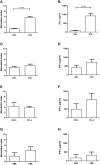Cellular Markers of Active Disease and Cure in Different Forms of Leishmania infantum-Induced Disease
- PMID: 30483480
- PMCID: PMC6243388
- DOI: 10.3389/fcimb.2018.00381
Cellular Markers of Active Disease and Cure in Different Forms of Leishmania infantum-Induced Disease
Abstract
Increased numbers of peripheral blood mononucleocytes (PBMC) and increased IFN-γ secretion following in vitro challenge of blood samples with soluble Leishmania antigen (SLA), have been proposed as biomarkers of specific cell-mediated immunity, indicating that treatment of visceral leishmaniasis (VL) has been successful. However, Leishmania infantum infection may manifest as cutaneous leishmaniasis (CL), and less commonly as localized leishmanial lymphadenopathy (LLL) or mucosal leishmaniasis (ML). The present work examines the value of these biomarkers as indicators of cured leishmaniasis presenting in these different forms. Blood samples were collected before and after treatment from patients living in Fuenlabrada (Madrid, Spain), an L. infantum-endemic area recently the center of a leishmaniasis outbreak. All samples were subjected to Leishmania-specific PCR, serological tests (IFAT and rK39-ICT), and the SLA-cell proliferation assay (SLA-CPA), recording PBMC proliferation and the associated changes in IFN-γ production. Differences in the results recorded for the active and cured conditions were only significant for VL. PCR returned positive results in 67% of patients with active VL and in 3% of those with cured leishmaniasis. Similarly, rK39-ICT returned a positive result in 77% of active VL samples vs. 52% in cured VL samples, and IFAT in 90% vs. 56%; in the SLA-CPA, PBMC proliferation was seen in 16% vs. 90%, and an associated increase in IFN-γ production of 14 and 84%, respectively. The present findings reinforce the idea that PBMC proliferation and increased IFN-γ production in SLA-stimulated PBMC provide biomarkers of clinical cure in VL. Other tests are urgently needed to distinguish between the cured and active forms of the other types of clinical leishmaniasis caused by L. infantum.
Keywords: IFN-γ; biomarker; cell proliferation assay; cure; cutaneous leishmaniasis; lymphadenopathic leishmaniasis; mucosal leishmaniasis; visceral leishmaniasis.
Figures

Similar articles
-
Cytokine Release Assays as Tests for Exposure to Leishmania, and for Confirming Cure from Leishmaniasis, in Solid Organ Transplant Recipients.PLoS Negl Trop Dis. 2015 Oct 23;9(10):e0004179. doi: 10.1371/journal.pntd.0004179. eCollection 2015. PLoS Negl Trop Dis. 2015. PMID: 26496365 Free PMC article.
-
Antigenicity of Leishmania-Activated C-Kinase Antigen (LACK) in Human Peripheral Blood Mononuclear Cells, and Protective Effect of Prime-Boost Vaccination With pCI-neo-LACK Plus Attenuated LACK-Expressing Vaccinia Viruses in Hamsters.Front Immunol. 2018 Apr 23;9:843. doi: 10.3389/fimmu.2018.00843. eCollection 2018. Front Immunol. 2018. PMID: 29740446 Free PMC article.
-
IFN-γ, IL-2, IP-10, and MIG as Biomarkers of Exposure to Leishmania spp., and of Cure in Human Visceral Leishmaniasis.Front Cell Infect Microbiol. 2017 May 31;7:200. doi: 10.3389/fcimb.2017.00200. eCollection 2017. Front Cell Infect Microbiol. 2017. PMID: 28620584 Free PMC article.
-
Biomarkers Associated With Leishmania infantum Exposure, Infection, and Disease in Dogs.Front Cell Infect Microbiol. 2018 Sep 6;8:302. doi: 10.3389/fcimb.2018.00302. eCollection 2018. Front Cell Infect Microbiol. 2018. PMID: 30237985 Free PMC article. Review.
-
[Feline leishmaniasis: what's the epidemiological role of the cat?].Parassitologia. 2004 Jun;46(1-2):203-6. Parassitologia. 2004. PMID: 15305717 Review. Italian.
Cited by
-
CD4+ Th1 and Th17 responses and multifunctional CD8 T lymphocytes associated with cure or disease worsening in human visceral leishmaniasis.Front Immunol. 2024 Feb 12;15:1277557. doi: 10.3389/fimmu.2024.1277557. eCollection 2024. Front Immunol. 2024. PMID: 38410517 Free PMC article.
-
Biomarkers in Post-kala-azar Dermal Leishmaniasis.Front Cell Infect Microbiol. 2019 Jul 31;9:228. doi: 10.3389/fcimb.2019.00228. eCollection 2019. Front Cell Infect Microbiol. 2019. PMID: 31417876 Free PMC article. Review.
-
Memory T cells: promising biomarkers for evaluating protection and vaccine efficacy against leishmaniasis.Front Immunol. 2024 Feb 26;15:1304696. doi: 10.3389/fimmu.2024.1304696. eCollection 2024. Front Immunol. 2024. PMID: 38469319 Free PMC article. Review.
-
A candidate vaccine for human visceral leishmaniasis based on a specific T cell epitope-containing chimeric protein protects mice against Leishmania infantum infection.NPJ Vaccines. 2020 Aug 13;5:75. doi: 10.1038/s41541-020-00224-0. eCollection 2020. NPJ Vaccines. 2020. PMID: 32821440 Free PMC article.
-
Evaluation of the protective efficacy of a Leishmania protein associated with distinct adjuvants against visceral leishmaniasis and in vitro immunogenicity in human cells.Parasitol Res. 2020 Aug;119(8):2609-2622. doi: 10.1007/s00436-020-06752-x. Epub 2020 Jun 13. Parasitol Res. 2020. PMID: 32535734
References
-
- Ajdary S., Alimohammadian M. H., Eslami M. B., Kemp K., Kharazmi A. (2000). Comparison of the immune profile of nonhealing cutaneous Leishmaniasis patients with those with active lesions and those who have recovered from infection. Infect. Immun. 68, 1760–1764. 10.1128/IAI.68.4.1760-1764.2000 - DOI - PMC - PubMed
-
- Carrillo E., Carrasco-Antón N., López-Medrano F., Salto E., Fernández L., San Martín J. V., et al. . (2015). Cytokine release assays as tests for exposure to Leishmania, and for confirming cure from leishmaniasis, in solid organ transplant recipients. PLoS Negl. Trop. Dis. 9:e0004179. 10.1371/journal.pntd.0004179 - DOI - PMC - PubMed
Publication types
MeSH terms
Substances
LinkOut - more resources
Full Text Sources
Medical

